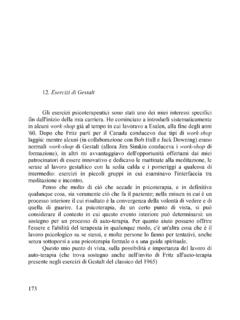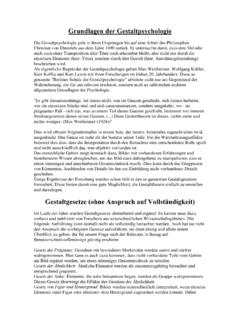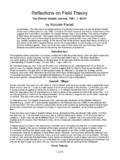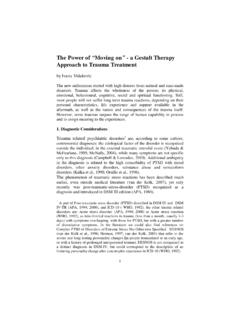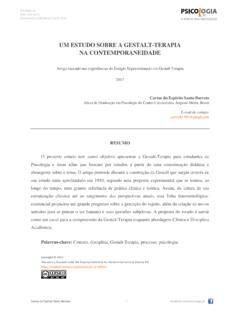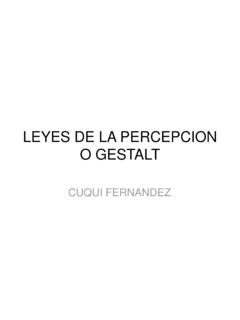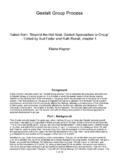Transcription of Gestalt Exercises* Claudio Naranjo, M.D.
1 Gestalt Exercises* Claudio naranjo , Psychotherapeutic exercises have been a particular interest of mine since early in my career. I started introducing these systematically in certain workshops at a time when I worked at Esalen in the late 60s. After Fritz left for Canada, I conducted two kinds of workshop there: Some (in collaboration with Bob Hall and Jack Downing) were regular Gestalt workshops (Jim Simkin conducted the training workshops at the time); in others I took advantage of the opportunity given to me by my sponsors to be innovative and devoted the mornings to meditation, the evenings to Gestalt hot seat work, and the afternoons to something in between: exercises in small groups where I explored the interface between meditation and encounter. I think that much of what happens in psychotherapy is truly the doing of the patient, inasmuch as it is an internal process out of which converge the will to see and the will to heal.
2 Psychotherapy, from one point of view, might be seen as a context in which this inner event can happen: as support for a self-therapeutic process. Whatever the measure of help that can be offered by the being and skill of the therapist anyhow, there is such a thing as working on one s self psychologically, and many people do so gropingly even without exposure to formal psychotherapy or spiritual guidance. This view of mine on the possibility and importance of work on self therapy supported by Fritz s own invitation to self therapy in the Gestalt exercises in the beginning of the 1951 classic, Gestalt Therapy always interested me in devising interpersonal structures that would embody general therapeutic principles and might thus be helpful ways for people to carry out mutually assisted work on themselves. In the course of the years I have even refined the mini-lab situation to the point of obtaining substantial therapeutic results through the supervision of such a process of people working with each other.
3 I had occasion to use therapeutic exercises for small groups intensively in the early 70s, in connection with the teaching experiment that became SAT Institute an _____ * From Gestalt Therapy: The Attitude & Practice of Atheoretical Experientialism (Nevada City, CA: Gateways, 1993), pages 235-248). aspect of which was the engineering of a group into a self-healing system. Small group exercises in this venture served both a therapeutic and a training aim, and among them there was a series of Gestalt drills in which I sought to provide an opportunity for participants to concentrate on the development of specific skills such as listening, monitoring their awareness continuum, observing body language, reflecting, and so on. The Gestalt exercises that I have collected in this chapter have in common a dual relevance to therapy and training. The first three emphasizing the sense of presence and the sense of I/You as distinct from I/It in place of the other I have come to regard a desirable background to all psychotherapy training, along with all aspects of the awareness continuum.
4 The particular description of the latter, given next, is taken (except for the introductory comments) from a workshop transcript, and illustrates one particular variation of that genre which I am calling the awareness continuum in a meditation context. Meditation context here stands not only for the meditation field provided by the meditative attitude of the listener, but for the confinement of the meditation awareness itself in view of an understanding of meditation through selective emphases on such issues as letting go, body awareness, feeling awareness, panoramic awareness, and so on. Also the last series of exercises, concerning topdog/underdog conflict, constitute an excellent opportunity for training as well as a therapeutic opportunity in that the coaching of a person through its four stages involves, besides the exercise of intuition, the skill to stimulate emotional expression, and anger in particular.
5 When I did and shared my spiritual recipe, I could not fail to appreciate Fritz in retrospect for the I/You exercise that he prescribed that I had failed either to practice or pass along with the rest of the Gestalt heritage. Fritz s exercise was one in which two people were actually saying strings of I s and You s in different combinations and rhythms in alternation. Just as I then felt that the experience did not go much further than a word game, there may be others who have failed to appreciate the important issues involved: I-am-ness in balance with the sense of other-ness. Some of the exercises I discovered myself and described for others may be of help for others who have never focused before on the I/You issue. I have applied them to many groups of people who have found them both personally meaningful and a substantial aspect of their professional training.
6 Though I have presented here the three I/You exercises in such little space that they may be read in virtually no time, I think that the experience of each deserves the opportunity of deepening through practice particularly in group situations through rotation among group members over many meetings. Also, in the course of time, I have come to know well the training value of many of these exercises, particularly since the time I first devised a therapeutic training program, during the 70s in the SAT Institute. Since then I have liked best a situation that is neither one of pure therapy nor one of professional training: a hybrid one of developing the potential therapists among laymen, while shaping groups into self-therapizing psychological self-maintaining systems. Though in this activity of combining sophisticated microlab work and therapeutic training I have drawn on inspiration beyond Gestalt therapy alone, my practice has naturally been strongly influenced by Gestalt ; for the purpose of this chapter I am selecting some exercises that can be regarded as direct embodiments of Gestalt ideas.
7 I. I/You exercises The first exercise , below, may be seen both as a development of something implicit in Gestalt therapy and as a borrowing from Sufism: the exercise of focusing on the sense of presence or selfhood. The second, likewise, may be regarded both as an elaboration of something already present in the Gestalt approach and a borrowing: the cultivation of the sense of personhood of the other, the sense of You in contradistinction to the experience of it. Working separately both with myself and with others on these two techniques, I naturally discovered the power of their combination: the exercise of being at the same time mindful of self and of others presence and being. 1. Presence Sit face to face with one another and close your eyes. Pay attention to your body sensations, posture and facial expression, and make any corrections in posture or attitude as such awareness may invite.
8 Be as you want to be moment after moment. Now open your eyes, yet remaining still in body and thought. Relax your eyes, yet remaining still in body and thought. Relax your body and let yourself be at ease, not trying to do anything and as you allow your mind to become silent, concentrate on the sense of existing Feel I am here. After some time concentrating on the I-sense while relaxing with a silent mind, bring your breathing into awareness and shift your attention from I to here and mentally repeat I am here in synchrony with in-breath, pause, and out-breath (don t attempt to do anything in particular during the out-breath pause). Go on with as much continuity of attention as possible. 2. You-ness As before, begin by sitting face to face, closing your eyes, optimizing your posture, attitude, and state. Then, after a time of letting yourself be in peace as much as you can, open your eyes, while you sit, physically relaxed and centered engaging in neither verbal nor nonverbal dialogue forget yourself as much as possible while you focus on the sense that the person before you truly exists, is a person and not a thing, a conscious being seeing you.
9 3. I/You After preparatory centering as before, here the two continuing to sustain mental silence with open eyes and with the support of physical relaxation, concentration on both I and you, while at the same time evoking a sense of infinity around them. Try it seeking to intensify at the same time the sense of presence in self and other and a sense of cosmic depth. Let the sense of infinity support your relaxation and dissolve your mind. Perhaps you may find it useful to say at times subvocally: I You Infinity. II. The awareness continuum in a meditative context The awareness continuum is to Gestalt therapy what free association is to psychoanalysis: both the beginning and the end of therapy. The beginning, in that it provides the mirror in which a person s psychological difficulties are reflected and from which the therapist takes his cues; the end, in that, just as the ability to free associate without resistance may be regarded as a sign of completeness of analysis, the ability to experience fulfillment and depth in every here-and-now is the goal of Gestalt .
10 I believe that, despite much talk about the awareness continuum, its practice is not given all the attention it deserves for it tends not to be viewed enough as a practice the practice of a healthy present-centered attitude but, rather, merely a point of departure for other therapeutic interventions and directions. Since I regard it as a valuable psychological exercise in its own right, and one which will be best carried out with the stimulus of interpersonal communication, I usually schedule it as a complement to therapy proper, and in variations such as the one below as a part of training. Those who have experience with the awareness continuum exercise cannot have failed to notice that, as is the case with psychological exercises in general, it is sometimes fulfilling and productive, sometimes superficial: a string of seemingly meaningless self-reports, most typically an inventory of perceptions: Now I look at the rug, now I hear a car passing by, etc.
